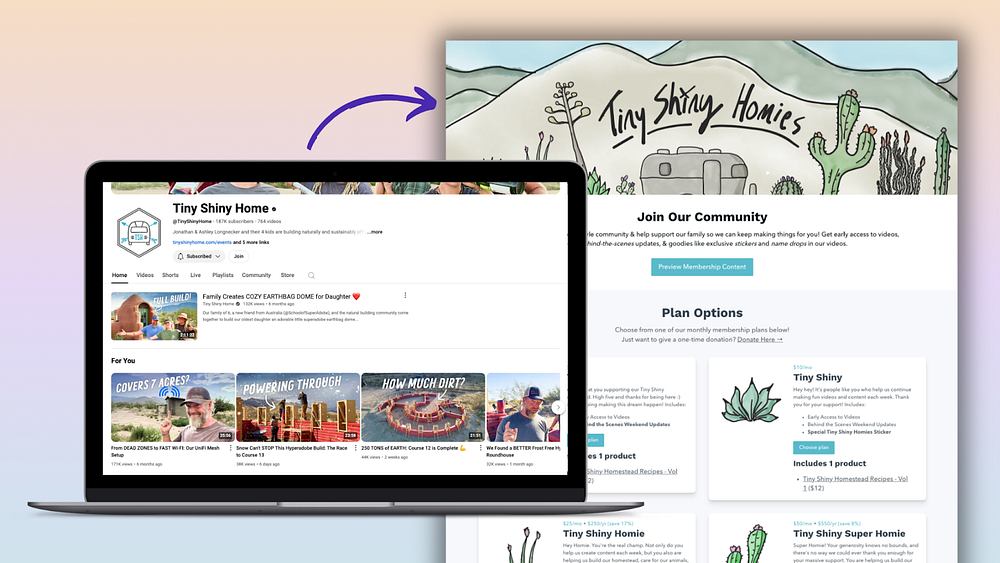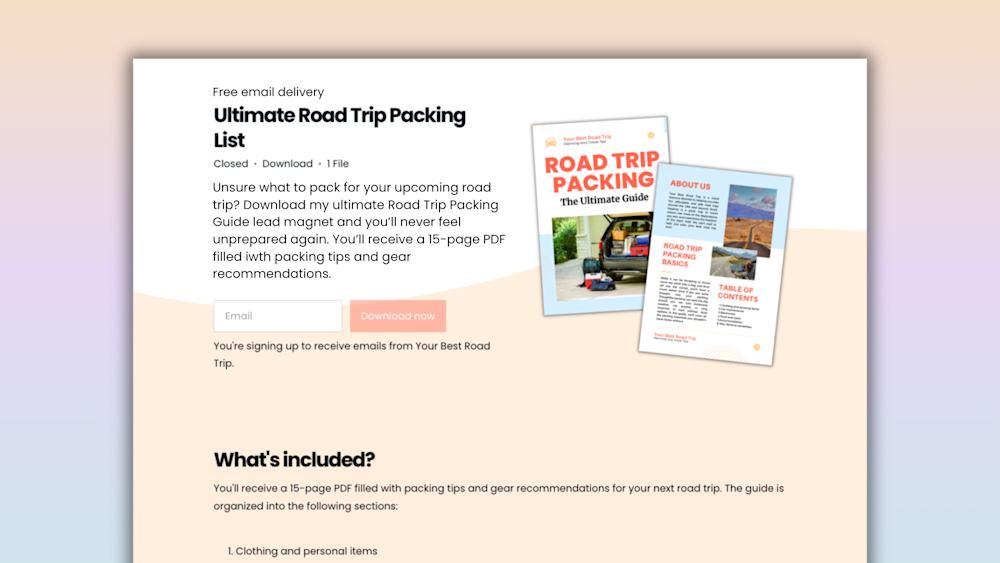You sit down to write a blog post, and… blank page. Pretty deflating, right? You have so many ideas you want to share, but you feel stuck, so you never press that publish button.
Is this blog post actually going to help my business?
Am I writing about the right things?
How will blasting my thoughts into the void lead to more money?
Why bother? No one’s reading this anyway.
You’ve tried all the blogging tips from the gurus and none of it has led to more sales and growth in your business. Now, your blog is starting to feel like an endless content treadmill.
It’s pretty miserable to waste hours writing blog posts that no one will read, earning you exactly zero dollars for your business.
You need a strategy, and that strategy does not include throwing spaghetti at the wall and seeing what sticks.
Today, we’ll cover how to write blog posts that grow your audience and sales. We’re big fans of blogging here at Podia (which is how you found this article), and we’ll share exactly how we write posts that work for our business, so you can use the same strategy in yours.
You’ll learn how to:
-
Research topic ideas your audience actually wants you to write about (so you never have to wonder if a topic is worth covering)
-
Write blog posts that answer burning questions, using a tried-and-true blog post template
-
Publish your blog posts and distribute them for more reach, all while keeping the search engines happy
-
Build an automated system that keeps you in contact with your blog readers long into the future, so you can earn more sales and build a loyal fan base
Step 1: What problem does your blog post solve for your audience?
I’m guessing that you started your online business to help people. Maybe you coach people to be more mindful in times of stress, or help athletes improve their flexibility through yoga, or teach aspiring musicians to market their music, or show people how to paint better portraits.
And if you have a digital product, course, or coaching program, you probably made it with a specific type of customer in mind too.
Before you start writing any blog posts, think about the people you want to help with your business and products.
-
What questions do they have?
-
What are they stuck on?
-
What are their pain points?
-
What information do you have that could make their day 1% better?
Every blog post you write should answer a question that’s important to your target audience. Every blog post should show how you and your products/business/services can help. Helpful solutions make you stand out in the minds of your customers (and the search engines notice too!)
You might be thinking, “Great! I know exactly what my audience wants!” and that’s fantastic. But if you’re not sure what your people are curious about, here are a few ways to get answers from the source.
-
Look at questions and comments on YouTube, LinkedIn, Reddit, and social media posts related to your niche. If someone has a similar product or business to you, what kinds of questions are their followers asking on public forums?
-
Send a survey to your audience and ask what they’d be interested in reading about. You can use polls on social media, or send a survey on Google Forms or Typeform to your email list.
-
Go to Google or your preferred search engine and type in phrases related to your offers. Scroll down to see the “People also ask” section. This will give you a list of questions and phrases related to whatever you searched. Use these as inspiration for article topics. You can also look at what other bloggers are writing about in your niche to get ideas.
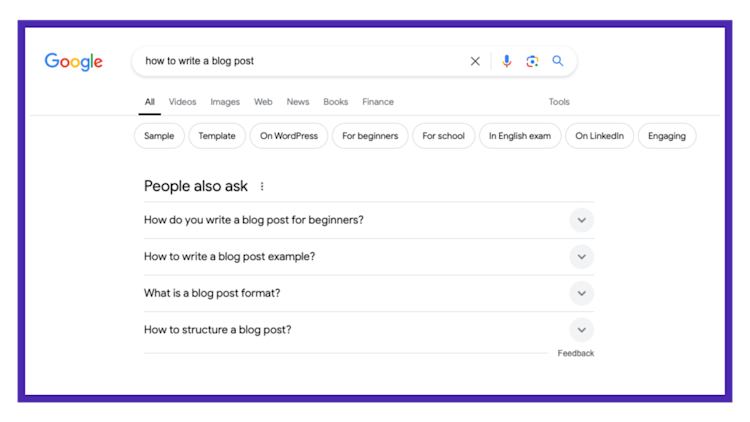
SEO Tip: A keyword is a single phrase that describes the main topic of your blog post. It can be a question or an overall description, and each article you write should contain just one focus topic.
For example, some keywords for different niches might be:
-
Chair yoga for lower back pain
-
Gluten-free chocolate chip cookie recipe
-
How do I make my dog stop barking?
For the blog post you’re reading right now, the keyword is “How to write a blog post.” More on how to use your keyword in the next section.
When you have some blog post ideas, brainstorm which ones feel the most aligned with your brand and business. Writing blog posts is most fun when it comes easily and flows naturally – like you were writing an email to a friend to help them out.
Leah Sugerman from Nomad Yoga says, “Write about what you know—a topic or subject that you're truly an expert in. Then it will flow effortlessly and naturally.” And it’s true! When I write about things I don't know much about, it takes so much longer. But when it’s a topic I’m passionate about that I know well, the writing process is faster and smoother.
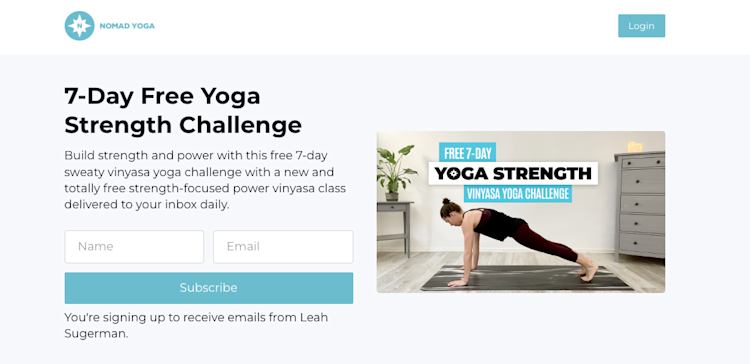
Leah also recommends creating an outline to make your blog post more cohesive, so let’s work on our outline next.
Step 2: Layout the problem, agitate it, and provide the solution
When you’ve decided on your main topic, you can use the following formula to outline and then draft your blog post. This outline is based on a well-known writing framework called PAS (Problem, Agitation, Solution), and this is the same framework we used to write the blog post that you’re reading now.
Problem: First, write the problem or main challenge that your reader is facing. Explain it clearly so they see that you understand their problem and can help.
Agitation: Then, reiterate to your audience why this problem matters and how nice it will be to get a solution. What happens if they don’t get a solution? What could life be like if they did?
Solution: Last, share the answer to their problem. This is the bulk of your article, where you give your tutorial, recipe, breakdown, instructions, or insights. If you have a free or paid product that can help, don’t be shy about promoting it alongside your advice!
Here’s an example PAS outline for an article titled “How do I make my dog stop barking”:
-
Problem: You’ve got a dog you love, but that dog can bark. It’s interrupting your work day and driving you (and your neighbors) nuts.
-
Agitation: You’re sick of being embarrassed at the dog park and you dream of the day you get a package delivered without a symphony of noise from your furry friend. It’s time for change, but nothing has worked in the past.
-
Solution: Here’s how to stop the barking once and for all.
-
Idea 1: …
-
Idea 2: …
-
Idea 3: …
-
Flesh out your outline first and remember to keep each blog post to one topic or keyword.
Then fill in the gaps to create your draft.
A quick reminder: Perfectionism can lead to writer’s block, so don’t worry about making every sentence perfect. Blog posts rarely are. The most important thing is that you help your reader solve a problem.
Once you’ve written your draft based on your outline, give it a proofread and run it through a tool like Grammarly or Hemingway for an extra set of eyes. These are free editing tools that can help you catch small errors before publishing.
Step 3: Publishing your blog post (and staying in touch with the people who read it!)
With your draft in hand, it’s time to publish. Podia has a built-in blogging feature that’s already connected to your products, website, and email list, and it only takes a few minutes to add your posts.
In the header menu, click on blogging and select new post. You can copy and paste your text right into the Podia editor, and add any images, videos, infographics, bullet points, embeds, files, and links you want.
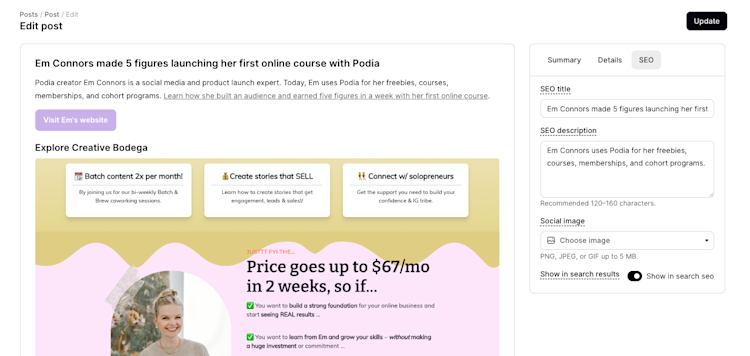
In the settings sidebar, you can add your blog title, meta description, and URL. You can also add a custom excerpt (this shows up as a blog post preview throughout your website) and a social sharing image to capture the reader’s attention.
A few SEO (search engine optimization) details to consider:
-
Use H2 and H3 headings to break up your sections. Subheadings give your article structure and make it easier to skim. Bonus points if you include relevant keywords in your headings.
-
Include your main topic keyword in your blog post title, description, and URL
-
If you have other blog posts related to the one you’re writing, add a link to them so people can click through and read more of your work. This also tells search engines that the two articles are related.
When your content is added, you can press publish to make it live. Podia automatically lets you share your blog post as a link or in an email newsletter, but more on that in just a moment.
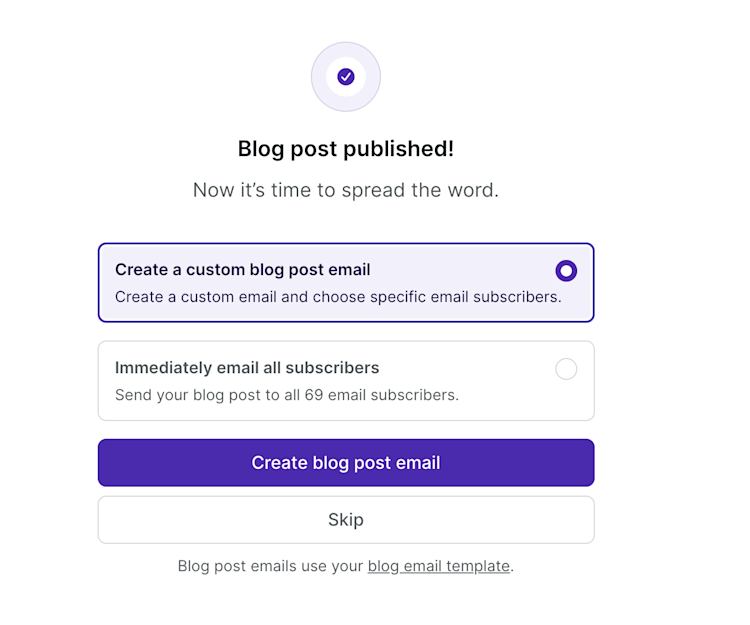
Next, you want to make it super easy for your readers to stay in touch with you long-term. The best way to do this is by adding email sign-up forms, lead magnets, or entry-level products to your blog post landing page and articles.
I recommend adding an email list sign-up form to the top or bottom of every blog post, as well as your blog post archive page. Don’t make your visitors hunt for it.
For example, Krystal Clark from Organize Your Empire has a lead magnet sign-up form at the bottom of her blog archive page. This lead magnet also shows up at the bottom of each post.
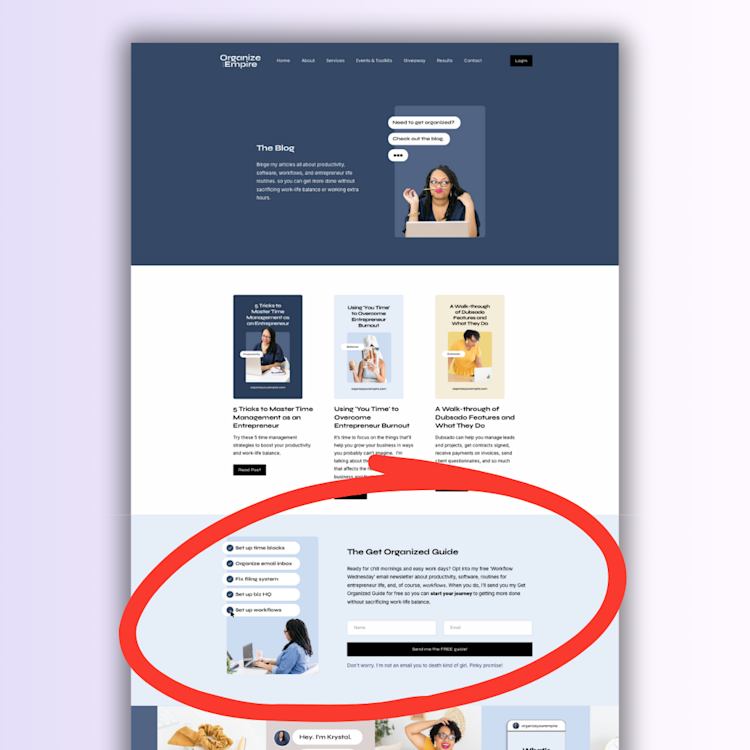
Why do you need an email list sign-up form or lead magnet on your blog posts?
You’ve already done all this work to attract a specific person to your site. They might not be ready to buy from you just yet, but there’s a good chance they’ll be interested in a free resource or newsletter about the topics you cover.
Once they’re on your email list, you can nurture the relationship by sending them email newsletters, or even automated email campaigns and sales funnels. The more you help them, the more likely they are to buy your products and tell their friends about how great your work is.
So your blogging system could look something like this:
-
You publish articles that help your audience members solve their pain points.
-
A person is looking for your blog post topic and they find you in the search engine results page! Hooray!
-
They love your article, and they see that you have a free lead magnet with more information about this topic.
-
They sign up and are automatically added to an automated email sequence with even more resources about this topic.
-
Eventually, you tell them about paid products you have, and they’ve seen how much value you provide for free. They’re ready to take the plunge, and you make the sale!
Now imagine how this system could grow with every blog post you publish. You could have dozens of articles reaching readers actively searching for the answers you provide.
These articles point everyone into an email funnel that helps them solve problems and gives them tons of value. Over time, the funnel automatically lets them know about your paid products, and whenever you have new offers you’ve got an enthusiastic audience who already knows and loves your work.
The more you write, the more people you help, and the more sales you make.
No more blogging into thin air. You’ve got a strategy now.
(Plus, everything listed above comes built-in with Podia, and you only have to set it up once and it will run on autopilot. Start your 30-day free trial today.)
Step 4: Distribute and repurpose your blog posts long into the future
If you close this article right now, you’ll have everything you need to write blog posts that grow your business. But if you want to go another step further, here are a few little bonus tips.
After a post is live, an easy way to get eyes on it right away is to share it with your email list. Podia has a built-in blog post emailing feature, so you’ll automatically be prompted to transform your post into an email broadcast when you press publish.
You can also:
-
Promote your blog posts in future newsletters, email campaigns, and other audience communications.
-
Post about it on social media and repurpose your blog post images into carousels
-
Use your post as a script for a podcast episode or YouTube video.
The beauty of a great blog post is that you can share it today, tomorrow, and long into the future.
Your system for writing great blog posts that attract customers and grow your business
Okay, you’ve got your system. You know how to research the right blog post topics, you have an outline for how to write good blog posts, and you know how to add a lead magnet or newsletter sign-up form to every post to turn your readers into long-term fans.
From here on out, everything you write makes your system stronger, more effective, and more profitable. No more content treadmill. No more blank pages.
Best of all, you can build everything covered in this article in Podia, and it’s free to get started. Sign up for your free 30-day trial and start publishing blog posts today.
Happy writing!
